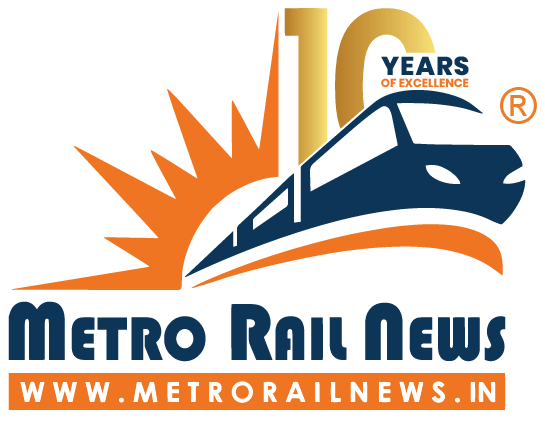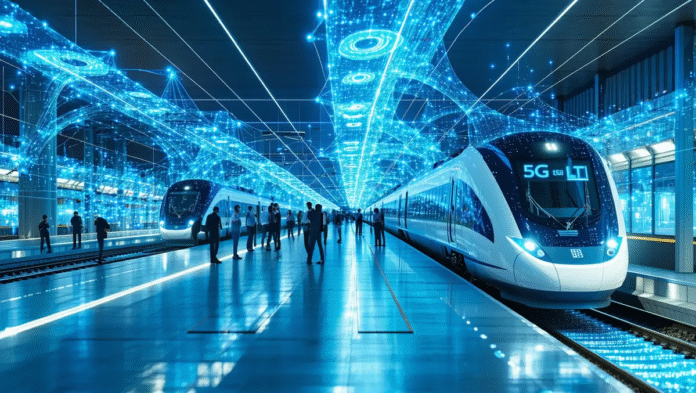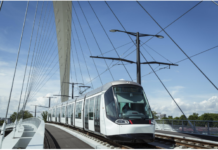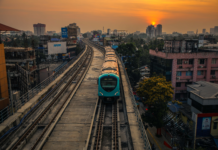Abstract
The pace of infrastructure growth in developing countries like India has been high in recent years. To complement this expansion, digital technologies have emerged as a cornerstone to support multiple sectors such as railways and banking. In India, the expansion of railway infrastructure aims to meet the nation’s increasing transport and logistics demands. However, managing the world’s fourth-largest railway network and the third-largest metro system poses challenges for operators. In this situation, rail operators must consistently maintain stringent benchmarks for safety, speed, reliability, and passenger comfort, even as network density and service expectations increase. To meet these demands, the sector is progressively adopting intelligent technologies such as automation, artificial intelligence (AI), and machine learning (ML), which collectively streamline the efficiency, safety, and responsiveness of train operations. However, implementing these systems requires advanced communication networks to minimise latency and enhance end-to-end data exchange between devices.
The deployment of 5G technology provides rail operators with the means to upgrade their communication infrastructure to meet current and future operational requirements. Its higher data transmission rates, increased capacity for simultaneous connections, low latency, and improved reliability facilitate the integration of advanced applications such as real-time signalling, continuous train monitoring, and large-scale IoT sensor networks. These functions support safety management, operational efficiency, and resource optimisation within railway systems. The metro systems have been quite ahead in the process of implementing modern communication systems across the infrastructure as compared to indian railways, which primarily operates on legacy infrastructure. The transition from legacy platforms, including GSM-R, to the Future Railway Mobile Communication System (FRMCS) will require operators to develop migration plans that ensure compatibility with existing assets while allowing for the adoption of 5G-based services.
This paper examines the role of 5G technology in enhancing the operational efficiency of railway systems and improving passenger services. It also analyses the technical and infrastructural challenges associated with integrating 5G into existing legacy communication and control systems.
Chronology of Communication Systems Adopted by Indian Railways
Indian Railways is one of the oldest railway systems in the world. It has evolved in every aspect over time to meet the nation’s demand for effective, reliable rail operations. Similarly, telecommunication infrastructure has progressed through various generations of technology from basic telegraph systems to advanced digital communications like GSM-R and LTE-R.
- Telegraphy (Mid-19th Century): Telegraphy was introduced shortly after the establishment of Indian Railways. It used Morse code over wired lines and served as the primary means of communication for transmitting train orders and facilitating communication between stations. This system supported basic train dispatching and operational coordination.

- Analog Telephony (Early 20th Century): During the early 20th century, analog telephony formed the backbone of railway communication systems in India. Communication was facilitated through physical lines that transmitted voice signals between control centres and train crews. While basic by today’s standards, this technology served as a reliable means of operational coordination at the time.
- Global System for Mobile Communications-Railway: GSM-R is based on standard GSM cellular technology, and it has been modified to meet the specific operational needs of railways. It uses both Frequency Division Multiple Access (FDMA) and Time Division Multiple Access (TDMA) techniques for radio communication. The system operates in the 900 MHz frequency band, with uplink frequencies ranging from 890–915 MHz and downlink frequencies from 935–960 MHz. GSM-R serves as the successor to Very High Frequency (VHF) systems. It facilitates voice and data transmission between train crews, control centres, and stations. Additionally, it supports data transmission for various applications, including train control systems such as the European Train Control System (ETCS).
- Long Term Evolution (LTE): Indian Railways is adopting LTE as a potential successor to GSM-R. LTE-R is a dedicated next-generation communication system designed for railway operations. IR had been allotted a 5 MHz spectrum in the 700 MHz band for the implementation of LTE services across its routes. It has been engineered for high-speed wireless transmission of both voice and data. It facilitates communication within trains, between trains and ground systems, and among trains themselves. In addition to operational functions, LTE-R can support a range of services, including passenger information systems, CCTV monitoring, traffic management, and ticketing, all on a unified network. The system is fully compatible with modern train control technologies such as the European Train Control System (ETCS) and maintains interoperability with legacy communication networks like GSM and UMTS. In 2024, the Government of India approved a project for the implementation of a Long-Term Evolution (LTE)-based Mobile Train Radio Communication system across 34,803 route kilometres of the Indian Railways network.
- Future Railway Mobile Communication System: The Future Railway Mobile Communication System (FRMCS) is a next-generation telecommunication system. It was developed by the International Union of Railways (UIC), in collaboration with various stakeholders from the rail sector. It is intended to succeed GSM-R and LTE. FRMCS is based on 5G technology and it provides reliable, low-latency, mission-critical communications for both routine operations and emergency situations. This technology is currently in the planning stage in India since the implementation of it will require a comprehensive migration plan and substantial capital.
Operational and Communication Demands Requiring 5G in Railways

The railway sector in India is experiencing high passenger volume, expanding freight requirements, and the need for higher operational efficiency. Traditional railway systems, designed decades ago, are reaching their structural and technological limits. Today, rail networks are denser, trains are faster, and expectations for safety, punctuality, and passenger experience are far higher than in the past. In addition, urbanisation has intensified congestion on metropolitan rail corridors, while national freight corridors are striving to move larger volumes at higher speeds. In this context, conventional signalling, communication, and maintenance methods still rely on legacy GSM-R systems, which are not sufficient to manage the complexity of modern operations. Below are some of the critical demands of the railway sector that can be addressed by the adoption of 5G.
Additionally, the government policies and infrastructure growth are creating huge space in the areas of automation and energy efficiency. Projects such as India’s Dedicated Freight Corridors, Mumbai-Ahmedabad High-Speed Rail Corridor, and the rapid expansion of metro networks highlight a paradigm shift toward modernisation of rail infrastructure. However, if India wants to achieve the operational standards of global rail systems such as those in Japan, China, or parts of Europe, it will need to initiate the full-scale adoption of digital technologies. 5G technology is not simply an improvement over existing systems. It acts as a foundational platform that can support the future of autonomous trains, smart stations, and fully integrated rail mobility networks.
Key requirements that can be addressed through the adoption of 5G include:
- Real-time information exchange: Both rail operators and passengers require faster, more reliable communication systems to enable immediate data transmission and informed decision-making. The high-speed transmission of data empowers the rail operators to control train movements, including speed, stopping, and routing.
- Emergency response: Limited communication capabilities can delay the ability of rail operators to respond effectively during emergencies, which increases the risk of operational and safety complications. The use of 5G-enabled networks can support faster data transmission and more reliable connectivity, which can enable faster coordination and response actions.
- Operational efficiency: The rail systems in India operate under immense pressure. To manage rising demand, operators traditionally need to either increase train frequency or invest in infrastructure expansion, both of which involve high costs and extended implementation timelines. By supporting advanced signalling technologies like Communication-Based Train Control (CBTC), 5G enables more precise train localisation, reduces headways, and increases line capacity without requiring physical expansion.
- Resource allocation: Continuous data collected from various assets such as rolling stock, station systems, and Automatic Fare Collection (AFC) units enables rail operators to analyse traffic patterns and optimise resource allocation. Additionally, this data stream supports AI-based energy management models that regulate traction power usage, control regenerative braking systems, and monitor station-level energy consumption. Implementing such data-driven strategies contributes to reduced operational costs and improved system efficiency.
- Predictive Maintenance: Indirectly, the 5G network helps in predictive maintenance. The implementation of 5G networks facilitates the large-scale deployment of IoT sensors across rolling stock, track infrastructure, and auxiliary systems. These sensors operate simultaneously and transmit continuous health data to centralised monitoring platforms. AI-based diagnostic models can analyse this data to detect early signs of component degradation or faults, allowing maintenance teams to take corrective action before issues escalate into failures. This approach reduces unplanned downtime and improves asset availability.
Enabling Smart Railways: 5G Infrastructure and Integration Framework
Indian Railways is operating on legacy systems. On the other hand, implementing 5G in railways requires a combination of advanced network infrastructure, dedicated hardware, and integration with existing railway systems.
- Radio Access and Trackside Equipment: . Radio Access Network (RAN): The RAN is the most critical component of any mobile network. In the context of railways, it consists of base stations, which are known in 5G as gNodeBs. These base stations are strategically installed along the tracks. These high-capacity stations send and receive data to and from moving trains and nearby infrastructure for continuous communication. These stations are supported by small cells for dense areas and tunnels.
- Massive MIMO Antennas and Beamforming
- Massive MIMO (Multiple Input, Multiple Output): Radio Access Network (RAN) in 5G systems is often paired with Massive MIMO (Multiple Input, Multiple Output). These are equipped with antenna elements that transmit and receive multiple data streams simultaneously.
- Beamforming: This advanced signal-processing technique focuses the wireless signal directly toward the train, instead of broadcasting it in all directions. This helps maintain a high-speed, stable connection even when trains move at 300–500 km/h.
- Trackside Towers and Masts: To make the communication effective, antennas and base stations need to be elevated above ground level by using trackside towers and poles. This ensures a clear line of sight between the base station and the moving train. This reduces interference and maintains signal strength.
- 5G Core Network (5GC): The 5G Core Network (5GC) acts as the backbone in 5G systems. 5GC handles the secure authentication and authorisation of users and devices accessing the network. It controls how data flows through the network. It connects the trackside base stations (gNodeBs) to various services and manages all critical functions, including authentication, mobility, and policy control.
- Ultra-Reliable Low-Latency Communication (URLLC): The 5GC enables extremely reliable and low-delay communication, which is essential for applications like automatic train operation (ATO), emergency braking, and real-time signalling.
- Network Slicing: The 5G Core allows the creation of multiple virtual networks (slices) over a shared physical network. Each slice can be dedicated to a specific use case:
- One for railway operations
- One for passenger internet and infotainment
- One for IoT-based asset monitoring
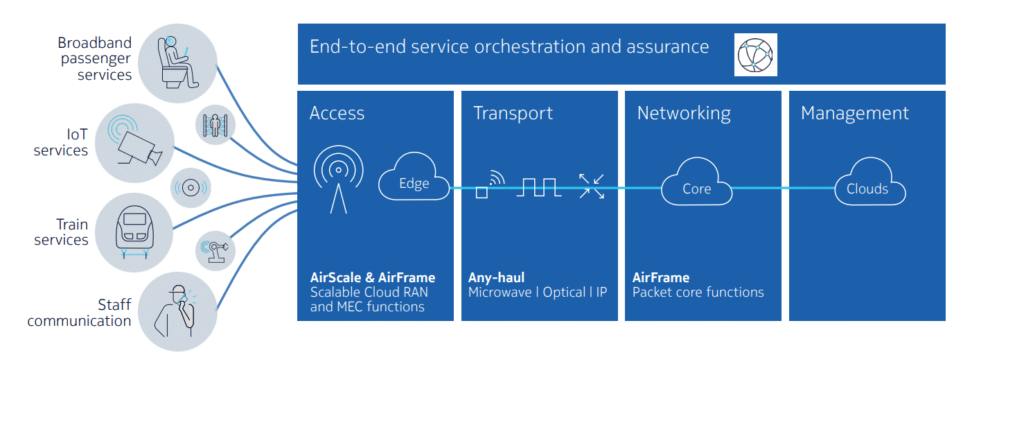
- Multi-access Edge Computing (MEC): To facilitate real-time decision-making and minimise response time, MEC servers are deployed near the railway tracks or stations. These nodes process data locally instead of sending it to a faraway cloud. Primarily, they help to identify faults instantly. MEC facilitates low latency and quick data handling, which is crucial for high-speed rail projects like MAHSR.
- Fiber-Optic Transport Network: All elements, including gNodeBs, MEC nodes, and centralised control systems, are interconnected through a fiber-optic.
- 5G Routers and High-Gain Antennas: In order to transmit the data, trains are equipped with roof-mounted high-gain antennas and ruggedised 5G routers to ensure continuous connectivity with the Radio Access Network (RAN).
- IoT Gateways and Data Collection: IoT gateways are installed inside train coaches to collect and transmit real-time data from various subsystems, including:
- Braking systems
- HVAC (Heating, Ventilation, and Air Conditioning)
- Wheel and axle sensors
The data collected from the sensors is transmitted at a very low latency rate in 5G systems, which minimises the response time in the case of an emergency.
- Spectrum Allocation for Dedicated Rail Operations: Indian Railways currently operates a hybrid communication ecosystem, which includes GSM-R for voice communication, Optical Fiber Cable (OFC) and IP/MPLS networks for data, and is in the early stages of adopting LTE-R. To meet future demands related to operational efficiency, safety, and automation, a transition to LTE-R and eventually 5G-R is essential. Presently, Indian Railways has access to a 5 MHz paired frequency spectrum in the 700 MHz band. However, this allocation may not be sufficient for fully realising the capabilities of LTE-R and 5G-R, particularly for high-throughput, low-latency applications. Additional spectrum will likely be required to enable parallel operation during migration and to support advanced features such as real-time train control, video surveillance, and Internet of Things (IoT) integration.
- Cyber Security Measures: As Indian Railways transitions to faster, digitally integrated systems like LTE-R and 5G-R, cybersecurity becomes a critical area of concern. These advanced networks carry sensitive data streams related to signalling, operations, ticketing, and monitoring systems. It becomes imperative to implement cybersecurity frameworks to ensure operational safety and data integrity.
The Roadblock in Implementing Future Railway Mobile Communication Systems (FRMCS) in India
Spectrum Allocation and Regulatory Hurdles: The 700 MHz frequency band is recognised as optimal for the deployment of LTE-R and 5G-based railway communication systems due to its wide coverage and strong signal penetration characteristics.
Indian Railways has been allotted 5 MHz (paired) Spectrum in the 700 MHz band (703-748 MHz Uplink & 758-803 MHz Downlink, also specified as Band 28 in 3GPP/ETSI standards) for implementing LTE services. However, it is not fully sufficient for supporting high-bandwidth applications such as real-time video surveillance, train control, and future 5G-based mission-critical communication systems. For facilitating network redundancy, parallel operation during migration, and long-term capacity, Indian Railways requires additional spectrum, ideally another 5 MHz within the same band. The allocation of further spectrum has become a subject of contention between the Department of Telecommunications (DoT) and the Telecom Regulatory Authority of India (TRAI). While Indian Railways has requested additional spectrum to modernise and secure its telecommunication infrastructure, DoT has conveyed to TRAI that further allocation will only be considered once the existing 5 MHz spectrum is fully deployed and utilised.
Pricing Dispute Over Railway Spectrum Allocation: A critical point of contention between the Department of Telecommunications (DoT) and the Telecom Regulatory Authority of India (TRAI) is the pricing model for assigning additional spectrum to Indian Railways. DoT advocates for using the Auction Determined Price (ADP), which reflects market prices discovered during the 5G spectrum auctions, while TRAI suggests using a formula-based approach that would be comparatively less costly.
During the 5G auctions, the ADP for the 700 MHz band was set at ₹3,927 crore per MHz for commercial use. If this rate is applied, acquiring an additional 5 MHz would impose a substantial financial burden on Indian Railways. Moreover, Indian Railways has not yet paid any charges for the 5 MHz of spectrum already allotted in the 700 MHz band, further complicating the issue. As per the DoT, this model will be implemented on the already allotted spectrum.
Cybersecurity Vulnerabilities: 5G’s high speed, low latency, and increased device connectivity can also be exploited for complex cyberattacks thats why a comprehensive cybersecurity model is necessary to protect signalling information, avoid unauthorised access, and secure railway networks based on IoT. As Indian Railways transitions to communication systems like LTE-R and 5G-R, the integration of railway-specific applications such as Automatic Train Protection systems (Kavach), Communication-Based Train Control (CBTC), and digital ticketing systems should be complemented with security measures. As Indian Railways and metro systems move towards 5G-enabled communication infrastructure, they become vulnerable to more sophisticated cyber threats. Some of the common attacks include:
- Distributed Denial of Service (DDoS) Attacks: The higher bandwidth of 5G can be exploited to launch high-volume DDoS attacks, which can overwhelm network infrastructure and disrupt mission-critical services.
- Exploitation of Core Network Vulnerabilities: The adoption of technologies like Software-Defined Networking (SDN) and Network Function Virtualisation (NFV) improves flexibility but also increases the attack surface.
- Signalling Spoofing: This could be the most dangerous attack among others, as hackers can manipulate signalling protocols to inject false commands into the system. In rail operations, such spoofing can lead to false instructions for train movement, which could potentially cause train collisions.
Migration from Legacy Systems: The transition from GSM-R to FRMCS (Future Railway Mobile Communication System), which is based on 5G, will include a prolonged period of dual operation. This coexistence necessitates that railways formalise a detailed migration plan for each stage of the transition.
- Technical Gaps: Various technical challenges will arise in the migration to FRMCS, including:
- Coexistence and Interference: The simultaneous operation of FRMCS and GSM-R raises concerns about potential interference.
- Deployment Model Selection: Identifying the most suitable deployment model for the 5G core network will be imperative.
- Infrastructure Requirements: Implementing FRMCS will necessitate the upgrade of existing infrastructure and the deployment of new equipment capable of supporting 5G-based communication. To maintain operational consistency, the infrastructure will need to support both GSM-R and FRMCS during a transition period. This dual-operation approach allows gradual migration without disrupting services. The sequence may involve:
- Workforce Requirements: A skilled workforce which is familiar with both legacy GSM-R systems and the new FRMCS technology is essential.
- Cost Implications: The shift to FRMCS will involve high capital expenditure as it will require investment not only for infrastructure upgrades and rolling stock retrofitting but also for maintaining two systems in parallel during the migration phase.
Conclusion
The indian rail transport industry is experiencing a paradigm shift toward modernisation. To improve its operations, the rail transport industry is leveraging automation and modern safety systems, which are backed by advanced communication systems. The rollout of 5G in railways is expected to enable high-speed operations by allowing data to be transmitted with low latency, which is essential for real-time control and monitoring. While the technology is still evolving in India, its future use can improve operational efficiency and help reduce costs for both metro and rail operators.
However, adopting 5G comes with several technical and operational challenges. These include the high cost of upgrading existing infrastructure, addressing compatibility issues, and developing a detailed migration plan to move from legacy systems to 5G-based systems without disrupting current operations. Additionally, as systems become more digital and connected, the risk of cyber threats increases. For example, interference with signalling systems or unauthorised access to control commands could affect train movement and safety. As a result, implementing strong cybersecurity measures will be essential to protect critical railway infrastructure as it transitions to 5G. As India explores the use of 5G in railways, the focus should remain on realistic planning, gradual implementation, and building secure systems that can support both current needs and future growth.
